10.Jul 2025
5 Most Common Problems in Handling Heavy Loads and Their Solutions
In the daily operation of industrial production, the same scenarios keep repeating. An operator loads a sheet into a press, a fitter rotates a glass panel to fit it into a frame, a warehouse worker loads a coil onto a pallet, etc. These tasks may seem simple and routine, and thus their impact on ergonomics, safety, and production efficiency is often underestimated. But it is precisely here that it is decided whether production runs long-term with low turnover, no injuries, and high quality – or not.
Manufacturing companies across sectors – from automotive to logistics – today face increasing demands for productivity, quality, and compliance with occupational health and safety regulations. While digitalization and automation focus on data and production flow management, physical material handling is often "overlooked" – relying on human strength, improvised solutions, or universal equipment not designed for the specific operation.
From the perspective of a production engineer or manager, handling is often the zone with the highest concentration of hidden costs and risks. This includes:
- repetitive movements and non-ergonomic work,
- back injuries and accidents during load placement,
- overloading of equipment and human resources,
- defects due to impacts or incorrect positioning,
- low work flow and frequent downtime.
In this context, manipulators offer an easy and safe way to handle loads. A well-designed and properly used manipulator can often deliver a relatively quick return on investment (ROI). The return depends on the specific application, the nature of the operation, the size, characteristics, and weight of the load, etc. Another benefit of using manipulators is overall employee satisfaction and health.
The Czech company TRIOM has long specialized in the custom manufacturing of manipulators and manipulator grippers. In our portfolio you’ll find single- and dual-joint manipulators, rail-mounted manipulators, and the option to order custom grippers tailored to your needs and requirements. We design grippers to match the type of load and the requirements of the specific operation.
The following five points summarize the most common technical and ergonomic issues in heavy load handling and propose possible solutions based on our experience and technical expertise.
Problem 1: Safe Gripping of the Load
Most injuries or damage during handling do not occur during the actual transfer, but while trying to grip or release the load. If the load is not gripped securely and stably, it can result in:
- sudden release and dropping of the load,
- unintentional shifting during handling,
- damage to the load (typically glass),
- the need for non-ergonomic operator intervention.
In practice, the biggest limitation is that universal gripping devices often don’t account for the specific characteristics of a given load type. Be it slippery surfaces, sharp edges, off-center gravity, high temperatures, or sensitivity to pressure.
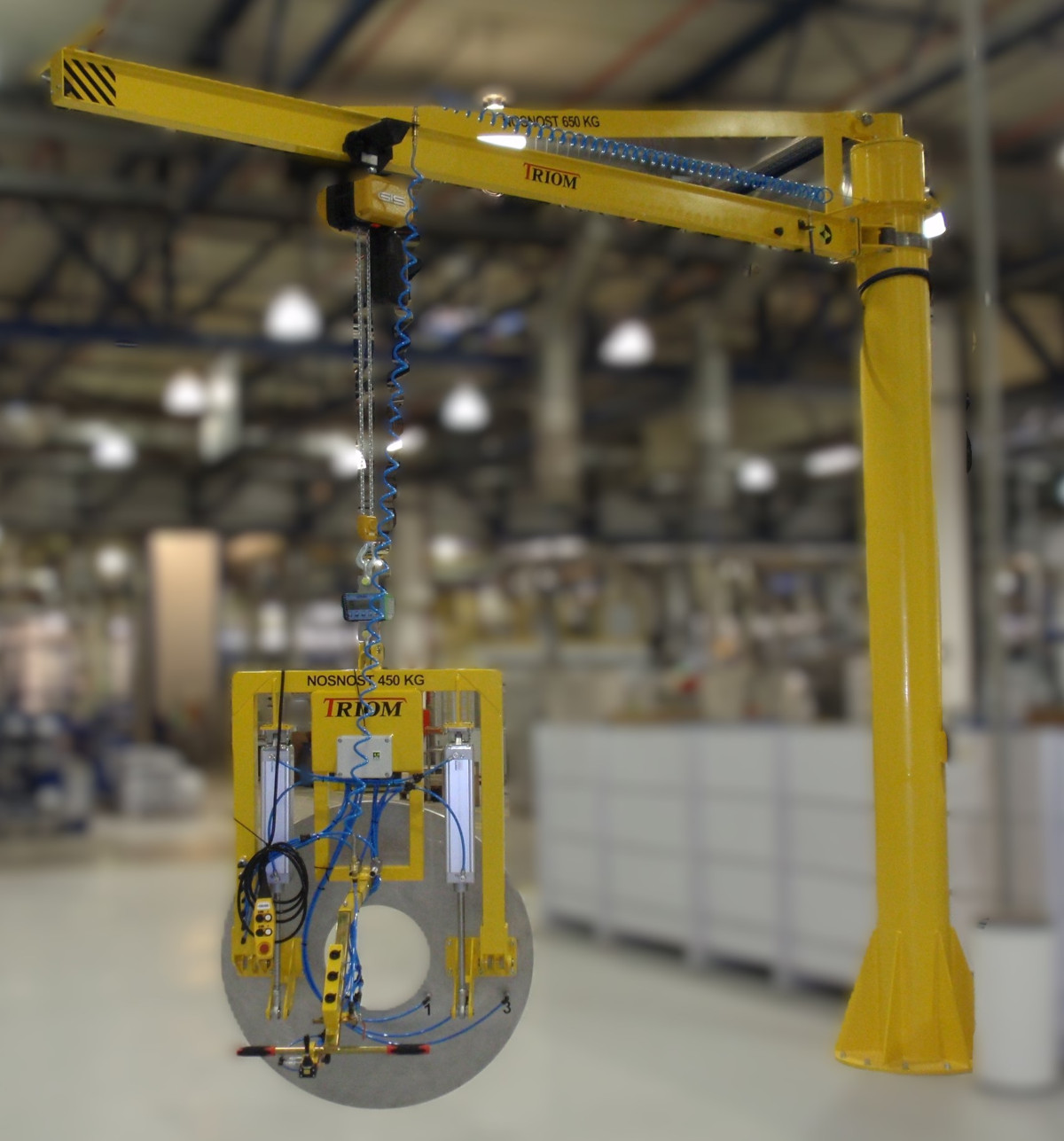
Our Solution: Grippers Tailored to the Load and Operation
TRIOM designs and manufactures custom grippers tailored to the specific shape, weight, surface, and functional requirements. These are not serial products but professionally developed solutions created in collaboration with the customer’s production teams.
Examples of gripping heads:
- Vacuum frames for handling sheets and glass – ensure even pressure distribution, gentle gripping without imprints or deformation.
- Clamp or hook grippers for coils – enable safe handling of heavier loads.
- Magnetic grippers for metal materials – resistant to heat and dusty environments.
Each gripper is designed with the load weight and required safety features in mind. Where appropriate, we add grip status sensors to prevent operational issues.
Problem 2: Handling in Confined or "Around-the-Corner" Spaces
In most operations, handling space is limited by the layout, orientation, and nature of the production area and technologies used. Sometimes loads must be placed “around the corner,” from the side, at an angle, or lifted to heights unreachable by standard equipment (e.g. cranes). Solutions are often improvised: operators lift manually, use straps, or choose unsuitable equipment.
Typical consequences:
- reduced safety (loss of control during handling),
- poor ergonomics (reaching over equipment, bending),
- low accuracy and slow handling.
Our Solution: Dual-Joint Manipulators with High Flexibility
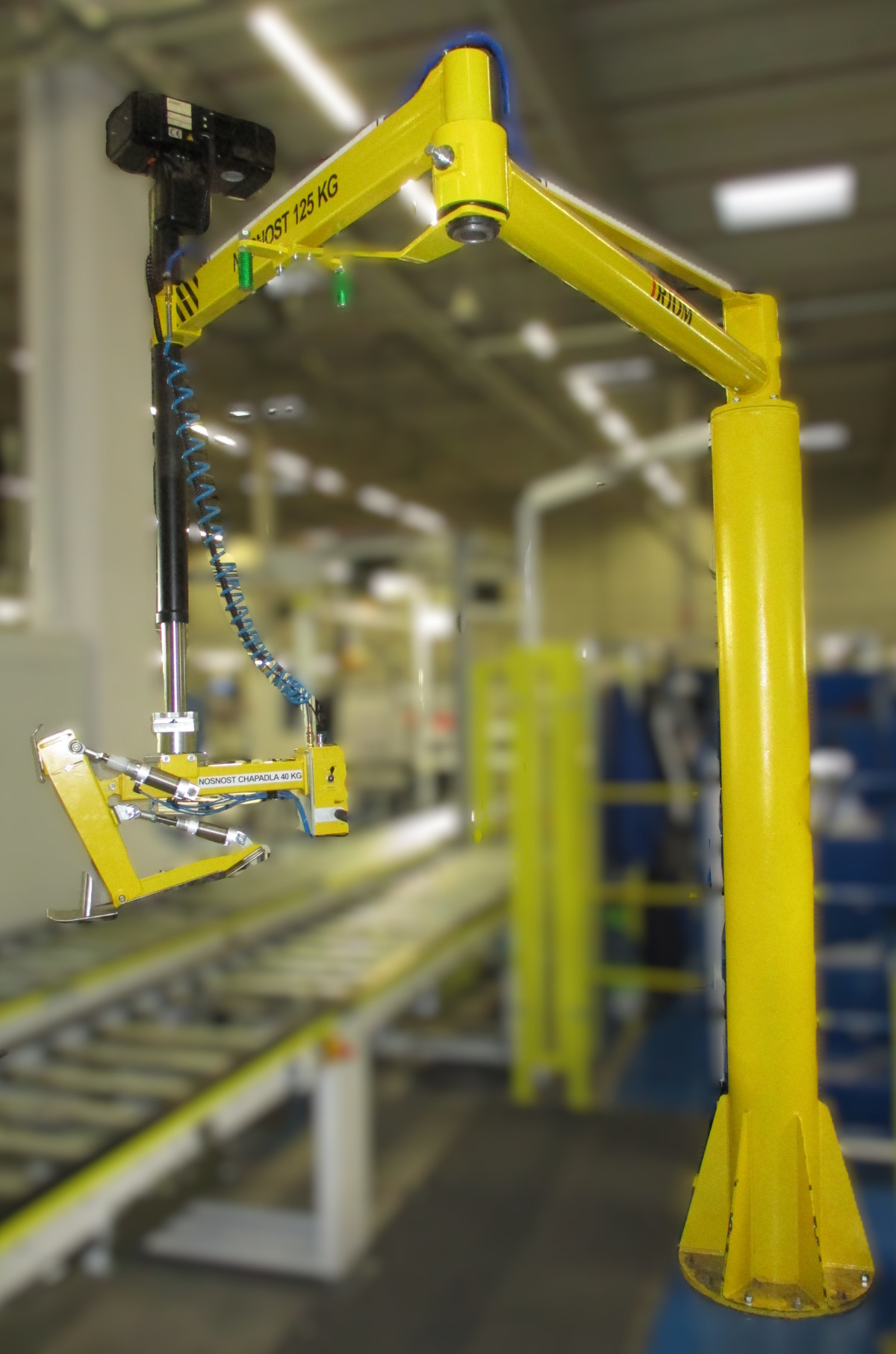
TRIOM develops dual-joint manipulators for such scenarios, allowing movement “around the corner” or rotation of the load. Unlike single-joint versions more suited for straightforward movement, the dual-joint design – especially with a telescopic arm and appropriate gripper – enables:
- rotation around multiple axes,
- complex positioning even in confined spaces,
- handling at various heights (depending on the arm size).
Combined with a custom gripper, this creates a tool that ensures safe, accurate, and ergonomic handling even in tight spaces. A telescopic arm can also be mounted on a rail. The equipment is thus tailored to the workstation layout – not the other way around.
Problem 3: Need for Precise and Smooth Positioning
In many operations – especially during assembly, installation, or precise placement – lifting and moving a load isn’t enough. Sometimes it must also be rotated or positioned. Think of installing bus doors or placing a heavy part in a precise position.
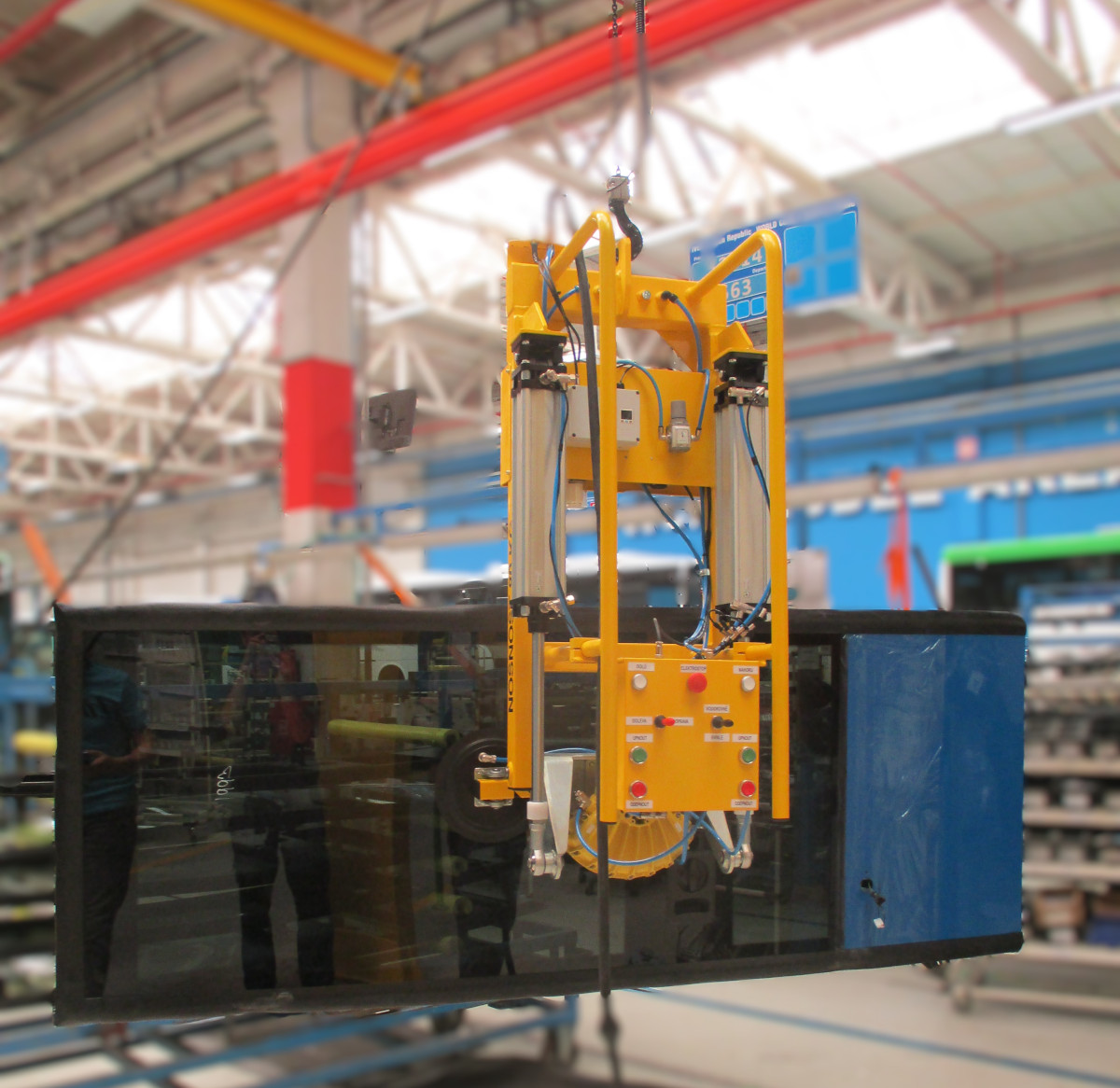
If the operator lacks equipment for fine and controlled movements, they are forced to:
- make manual “forceful” adjustments,
- repeatedly adjust the load’s position,
- risk damaging parts or fixtures,
- waste time on every operation.
This can lead to reduced productivity and increased risk of defects or injuries due to unexpected load movement or operator overstrain.
Our Solution: Smoothly Controlled Telescopic Arms
TRIOM addresses this need using telescopic arms integrated into dual-joint manipulators or rail systems. These allow:
- gentle linear lift with precise stop control,
- load rotation or tilting across multiple axes.
In combination with the right gripper (e.g. multi-point vacuum frame or custom head), operators can position even fragile or irregularly shaped loads. Control remains intuitive and under human direction.
Key benefits:
- eliminate impacts or swings that could damage the product,
- reduce time for manipulation or corrections,
- improve output quality without full automation.
Problem 4: Non-Ergonomic and Physically Demanding Work
Manual load handling is one of the most common reasons for absenteeism and employee turnover. Studies show that 30–40% of industrial injuries are related to spine or joint overloading. It’s not just about lifting, but also:
- repetitive movements in unnatural positions,
- carrying loads over short distances,
- reaching over equipment,
- twisting the torso while holding a load.
Despite valid standards (e.g. ČSN EN 1005-2), ergonomics is often affected by workspace limitations, budget, or simple lack of awareness of available technologies.
Our Solution: Column Manipulators Designed for Better Ergonomics
TRIOM offers column manipulators that allow operators to:
- lift, move, and position loads effortlessly,
- work at optimal height and angle, regardless of load size or target location,
- control movements smoothly and without shocks.
The device is designed so that required movements follow the operator’s natural motion – not the other way around. Hands stay in the safe zone, and movement is ergonomic. The load’s center of gravity is also stably balanced. All without complex automation. Especially useful in ATEX and food environments.
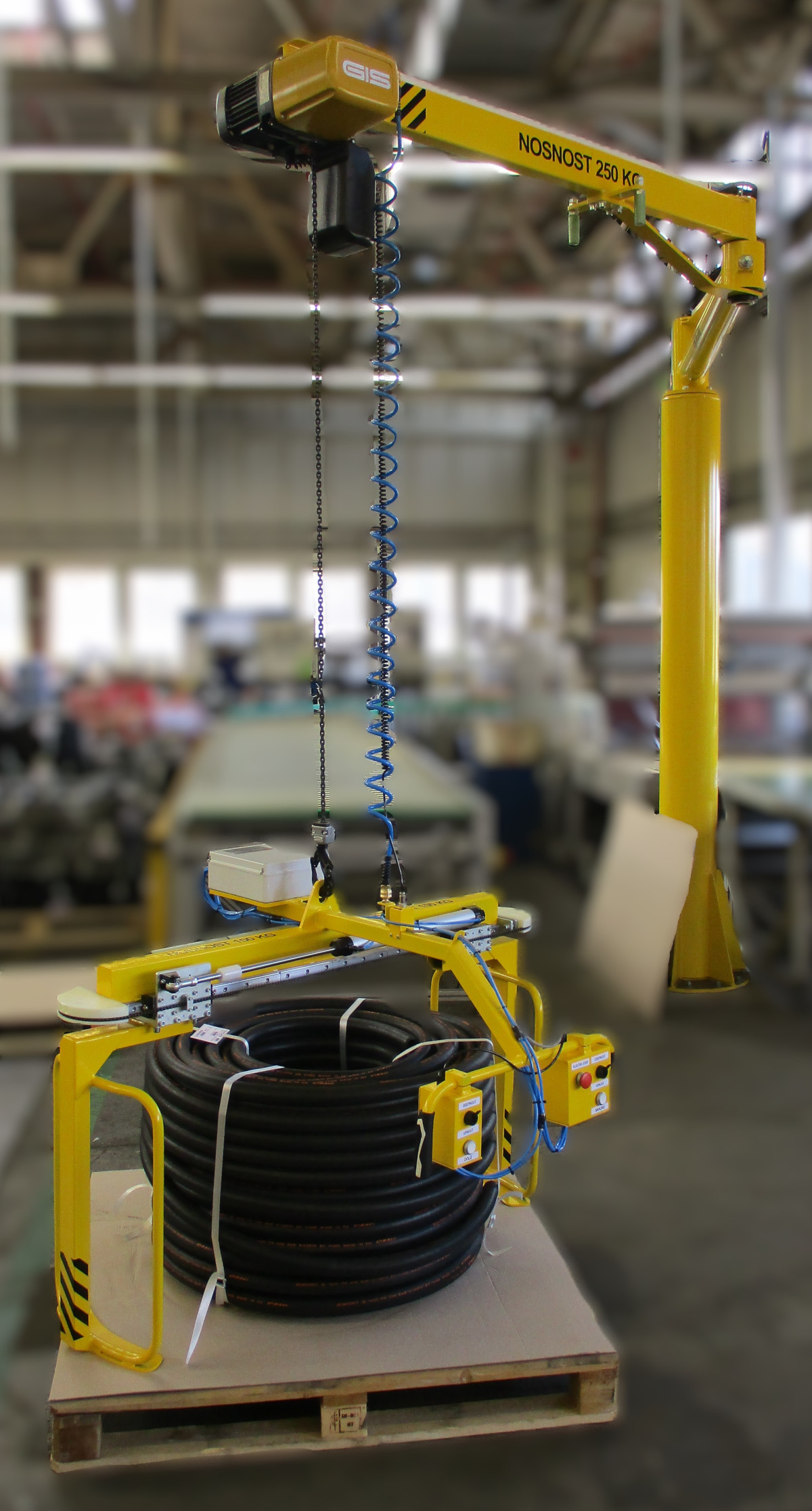
We can customize future devices not just to the load, but also to the specific operator’s body. Likewise, the manipulator can be adapted to space limitations.
Problem 5: Low Productivity and Inefficiency in Manual Handling
When a load needs lifting or moving and there’s no suitable tool available, the process results in:
- delays – workers waiting for a colleague,
- unplanned interventions – disrupting standard workflow,
- errors – parts placed incorrectly or damaged.
In the long run, this means lower productivity, higher costs, and worker stress. These losses are hard to predict or quantify and usually “dissolve” into many small delays.
Our Solution: Manipulators as Part of the Production Flow
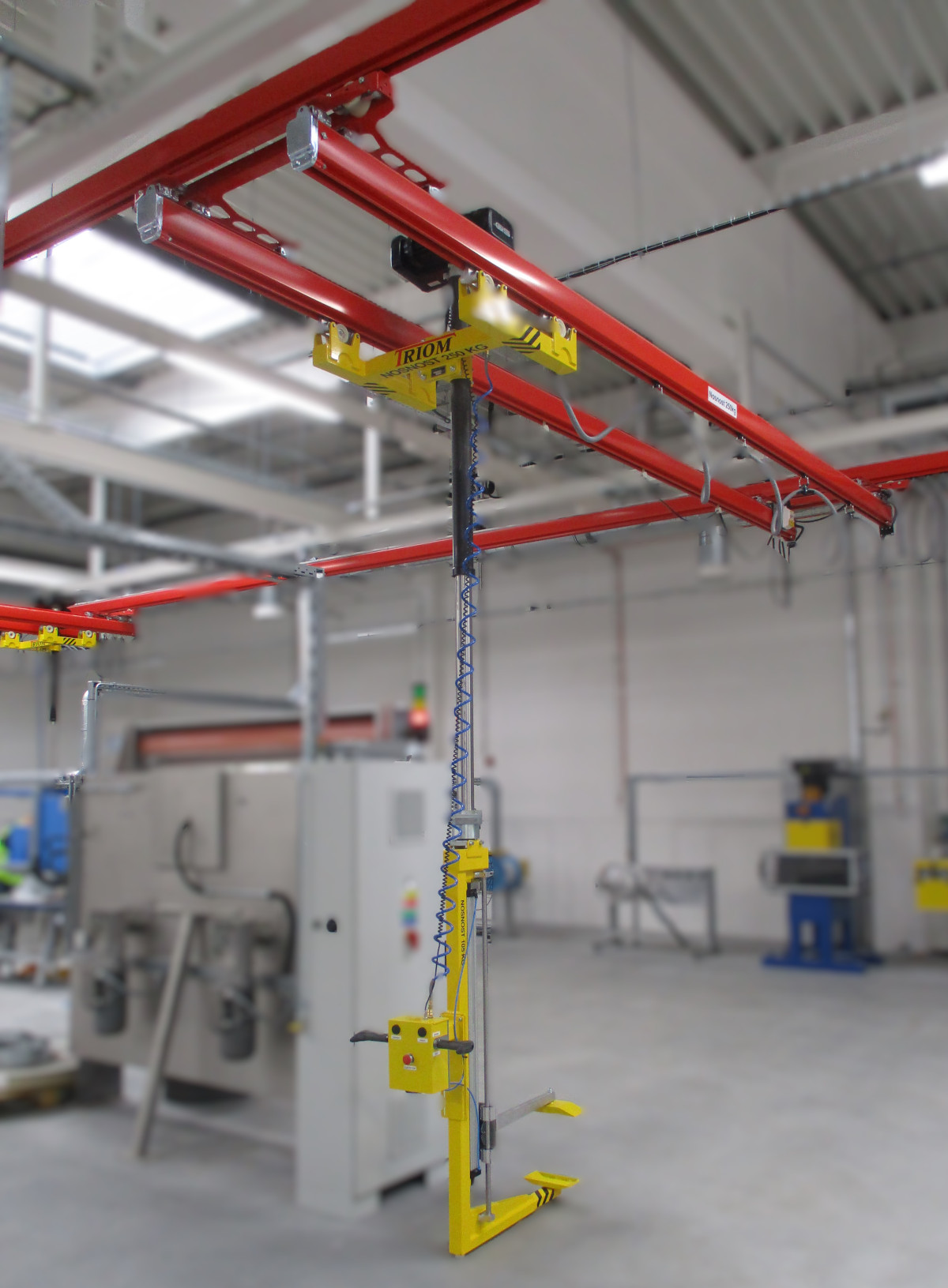
A properly selected manipulator becomes an integral part of the production process. TRIOM approaches each project with the goal to:
- design the manipulator as a part of the production process with focus on ergonomics,
- enable operators to work independently and smoothly, without relying on colleagues,
- minimize cycle interruptions due to error or physical exhaustion.
TRIOM manipulators can be adapted for use:
- in standalone assembly cells, where the operator performs multiple tasks,
- on rails or overhead systems, when a larger area needs to be covered.
Conclusion
Our primary goal is not to replace the worker, but to enable them to work consistently, precisely, and safely. Without the need for improvisation, waiting, or physical overload. This brings benefits not only in operational efficiency but also in the resulting motivation and stability of the entire team.

